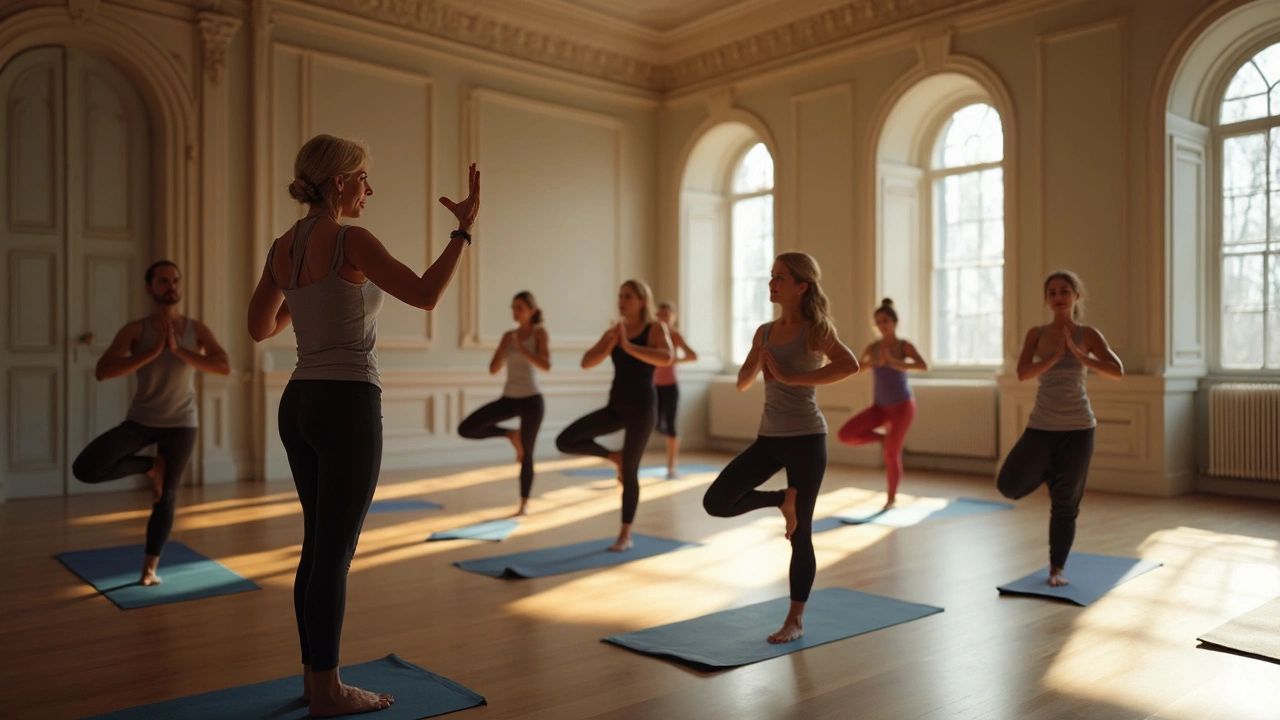Feeling your heart skip a beat might sound like something from a romance novel, but for those dealing with arrhythmias, it's a bit less poetic. Arrhythmias are irregular heartbeats, and while some are harmless, others can cause serious issues. So, how do you treat something like this? Besides medical interventions, incorporating yoga and meditation might be worth considering.
Yoga isn't just about stretching and impressive poses; it's deeply rooted in connecting mind, body, and spirit. When you practice yoga, you're working on reducing stress and fostering a sense of calm—something essential for heart health. Not to mention, the breathing techniques can help you manage the heart’s rhythm, potentially easing the symptoms of arrhythmias.
- Understanding Arrhythmias
- Yoga for Heart Health
- Benefits of Meditation
- Scientific Insights
- Getting Started
Understanding Arrhythmias
Alright, so let’s talk about arrhythmias. It's not just a fancy word—it’s a condition affecting many folks where the heart doesn't beat at a regular rhythm. Now, the heart usually beats in a steady lub-dub. But with arrhythmias, it might sprint like you're running a marathon even when you're just kicking back on the couch, or it could take awkward pauses. Not cool, right?
There are different kinds of arrhythmias. Some of the more common ones include:
- Atrial Fibrillation (AFib): The upper chambers of the heart quiver instead of beating effectively. This is one you usually hear about.
- Bradycardia: This is when the heart beats too slowly. For adults, that's usually less than 60 beats per minute.
- Tachycardia: The opposite of bradycardia—heart beats too fast, typically more than 100 beats per minute when at rest.
- Premature Ventricular Contractions (PVCs): Extra heartbeats that begin in the heart's ventricles, disrupting the regular heart rhythm.
What's the Big Deal?
Some arrhythmias are harmless, but others can lead to serious health problems if not checked. They can mess with your blood flow and may lead to strokes, heart failure, or other heart problems.
Real Talk: Why It Happens
Arrhythmias can be caused by lots of things: heart disease, high blood pressure, diabetes, smoking, excessive drinking, stress, or even some medications. Sometimes, it's just the way your heart decided to be. Here’s a quick look at some contributing factors:
| Factor | Impact on Arrhythmias |
|---|---|
| Heart Disease | Can damage heart tissue, leading to arrhythmias. |
| Stress | Increases adrenaline, which can throw off your heartbeat. |
| Alcohol | Can weaken the heart muscle if consumed in excess. |
Knowing all this is a good start to understanding how yoga and meditation might just be the calming agents your rebellious heart needs. But we'll get into that next!
Yoga for Heart Health
Diving into the world of yoga can seem a bit overwhelming at first, but it's one of the oldest health practices known to humans. For those dealing with arrhythmias, yoga isn't just about flexibility and balance, it's a holistic way to potentially improve heart health too.
Stress Reduction and Heart Rate
Stress is a common trigger for irregular heartbeats. By practicing yoga regularly, you can significantly lower stress levels. Lower stress means less strain on your heart and more regular rhythms. A typical session includes controlled breathing, gentle poses, and meditation—each aspect working together to calm your body and mind.
Yoga Poses for Heart Health
Some yoga poses are specifically beneficial for the heart:
- Mountain Pose (Tadasana): It's all about standing tall and breathing deeply. This pose helps improve posture and lung capacity.
- Bridge Pose (Setu Bandhasana): Known for its heart-opening benefits, it strengthens the back while improving circulation.
- Child's Pose (Balasana): Perfect for relaxation, it lowers stress and gently stretches your back and hips.
The Impact of Regular Practice
A consistent yoga routine can lead to real changes. A small-scale study noted that participants who practiced yoga noticed a drop in heart rate variability—a key factor in managing arrhythmias. While it's not a full cure, it's a simple, non-invasive approach to support overall heart health. Here's some interesting data on yoga’s impact on heart health:
| Yoga Practice | Heart Rate Reduction | Stress Level Reduction |
|---|---|---|
| Weekly | 5% | 10% |
| Daily | 10% | 20% |
Starting Your Yoga Journey
Before jumping in, it's helpful to talk with your healthcare provider, especially when dealing with heart issues. Once you’re cleared, maybe find a local class or online tutorials to guide you. Remember, consistency is key. Even a few minutes of yoga daily can make a difference over time.

Benefits of Meditation
When it comes to calming the mind and body, meditation is a powerful tool. It's not just about achieving a zen state; it's also about impacting your physical health significantly. For those dealing with arrhythmias, meditation may offer a way to find relief through practices that help regulate the heart's rhythm.
Reducing Stress Levels
Stress is a major trigger for irregular heartbeats. By practicing meditation, you engage in mindfulness activities that lower stress hormones in the body. This is great news for heart health, as less stress can equate to fewer episodes of arrhythmias.
Improving Heart Rate Variability
Studies have suggested that people who meditate regularly show an improvement in heart rate variability, a key marker of heart health. This means your heart can better respond to various stressors, reducing the likelihood of experiencing arrhythmias.
Practical Tips to Get Started
- Set aside just 10-15 minutes each day for quiet meditation. You don't need to spend hours to see benefits.
- Use a meditation app or guided session online to keep yourself on track and focused.
- Consistency is key. Try to meditate at the same time every day to create a habit.
Meditation Types to Explore
While there are many meditation styles, some focus more on breath control, which can be particularly useful for arrhythmia management. Consider trying these:
- Guided Imagery: Focus on calming images to soothe the mind and, by extension, the heart.
- Mindfulness Meditation: Stay present and aware, often focusing on the breath, which can help maintain a steady heart rate.
Incorporating these practices into your daily routine might just be the gentle nudge your heart needs to find its rhythm again.
Scientific Insights
Research into how yoga and meditation affect arrhythmias has been bustling with excitement. While more large-scale studies are needed, existing research gives us some fascinating insights.
Yoga's Impact on Heart Rhythms
In a study conducted by Harvard Medical School, participants with irregular heartbeats noticed a significant improvement after engaging in yoga sessions thrice weekly for 12 weeks. The results showed a decrease in heart rate variability, which is a tell-tale sign of reduced arrhythmia episodes. So, yeah, yoga might just give your heart some rhythm in the right way.
Meditation and Heart Health
Another pivotal study was conducted at Duke University, which focused on the role of meditation. Participants who practiced mindfulness meditation daily experienced a noticeable decrease in stress levels, which directly influenced heart rhythm stabilization. Stress is a notorious trigger for arrhythmias, so keeping it in check through meditation can be a game-changer.
| Study | Participants | Duration | Outcome |
|---|---|---|---|
| Harvard Medical School | 50 | 12 Weeks | Decrease in heart rate variability |
| Duke University | 40 | 8 Weeks | Lower stress levels, improved heart rhythm |
These preliminary findings suggest that integrating yoga and meditation into your routine isn't just about post-workout zen. They really can make a difference for those dealing with heart issues, particularly arrhythmias.
So, should you ditch your meds for a yoga mat? Not at all. Always consult with your healthcare provider before making changes to treatment plans. But, pairing conventional treatment with these holistic practices might just help harmonize your heartbeats.

Getting Started
Starting your journey with yoga and meditation to help manage arrhythmias doesn't require you to be an expert yogi or a zen master. All you need is a little space, a bit of time, and a dash of patience. Let's break it down into simple steps to make it approachable and effective.
Setting the Scene
To get started, find a quiet, comfortable space where you won't be disturbed. Some people set up a yoga mat or just use a soft carpet. The key is to create a peaceful environment that helps you focus.
Starting with Yoga
When it comes to yoga, begin with some basic poses such as the Mountain Pose, Downward Dog, or Child’s Pose. These are not only easy but also great for beginners. Focus on your breath as you hold each pose for a few seconds.
- Mountain Pose: Stand with feet together, arms at sides, and breathe deeply.
- Downward Dog: From all fours, raise your hips to form an inverted 'V' shape.
- Child’s Pose: Kneel, sit back on your heels, and stretch forward with your arms extended.
Meditation Techniques
Meditation is about calming the mind. Start with just 5-10 minutes. Sit comfortably, close your eyes, and focus on your breathing. When your mind wanders, gently bring it back.
"Consistent practice of meditation can lead to measurable changes in brain regions associated with memory, sense of self, empathy, and stress," says Dr. Sara Lazar, a neuroscientist at Harvard Medical School.
Creating a Routine
Try to incorporate these practices into your daily routine. Some find mornings best to set a calm tone for the day, while others prefer evenings to wind down. Whatever works for you, consistency is key.
Track Your Progress
Keep a simple journal or use a wellness app to note any changes in your heart rhythms and overall health. If you're a numbers person, portable heart rate monitors can provide precise feedback and keep you motivated.
Remember, start small, be patient, and listen to your body. Incorporating yoga and meditation into your life can be a supportive tool in managing arrhythmias effectively. Happy practicing!






Jasmine Hwang
February 13, 2025 AT 16:19katia dagenais
February 15, 2025 AT 09:56Josh Gonzales
February 17, 2025 AT 04:45Jack Riley
February 17, 2025 AT 16:09Jacqueline Aslet
February 18, 2025 AT 05:46Caroline Marchetta
February 19, 2025 AT 03:36Valérie Siébert
February 20, 2025 AT 15:14Adesokan Ayodeji
February 21, 2025 AT 08:04Karen Ryan
February 22, 2025 AT 18:37Terry Bell
February 24, 2025 AT 03:50Lawrence Zawahri
February 24, 2025 AT 09:32Benjamin Gundermann
February 24, 2025 AT 14:04Rachelle Baxter
February 25, 2025 AT 00:03Dirk Bradley
February 26, 2025 AT 23:21Emma Hanna
February 27, 2025 AT 02:51Mariam Kamish
February 28, 2025 AT 01:15Patrick Goodall
February 28, 2025 AT 15:53Manish Pandya
March 2, 2025 AT 03:30